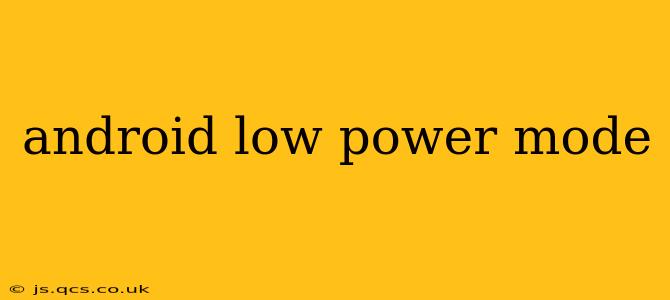Android's Low Power Mode is a lifesaver for anyone who's ever been caught with a dying phone battery. This feature significantly extends your device's battery life by intelligently limiting background activity and certain features. But how does it work, and what are its implications? This comprehensive guide will answer all your questions about Android's Low Power Mode.
What is Android Low Power Mode?
Android Low Power Mode is a built-in system feature designed to conserve battery power by restricting certain phone functions. When activated, it reduces background activity, limits performance, and dims the screen brightness, ultimately prolonging the battery's lifespan. The specific features limited can vary slightly depending on your Android version and phone manufacturer, but the core functionality remains consistent across devices.
How Does Android Low Power Mode Work?
The magic behind Low Power Mode lies in its selective throttling of system resources. It doesn't simply turn off everything; rather, it intelligently prioritizes essential functions while restricting less critical processes. Here's a breakdown of common restrictions:
- Reduced Background Activity: Apps running in the background consume significant battery power. Low Power Mode significantly restricts this activity, limiting or preventing data syncing, location updates, and other non-essential background tasks.
- Limited Performance: The CPU might be clocked down to a lower speed, resulting in slightly slower performance. This is a trade-off for increased battery life. Demanding tasks might take a little longer to complete.
- Dimmed Screen Brightness: Reducing screen brightness is a simple yet highly effective way to conserve battery. Low Power Mode automatically lowers the screen's maximum brightness, which can significantly extend usage time.
- Location Services Restrictions: Frequent location updates are a major battery drain. Low Power Mode often limits or disables location services for some apps.
- Data Usage Restrictions: Some versions of Android Low Power Mode can restrict background data usage, preventing apps from downloading updates or syncing data unless explicitly initiated by the user.
- Visual Effects Reduction: Animations and visual effects might be toned down or disabled entirely to reduce processing demands.
How to Enable and Disable Android Low Power Mode?
Enabling Low Power Mode is usually straightforward. The exact steps might vary slightly depending on your Android version and device manufacturer, but the general process is similar:
- Open Settings: Find and open the "Settings" app on your Android device.
- Find Battery Settings: Look for an option like "Battery," "Battery Saver," or "Power Saving Mode." The exact wording may differ.
- Enable Low Power Mode: Toggle the switch to enable Low Power Mode.
Disabling it is just as easy: Simply repeat the steps above and toggle the switch to the "off" position.
What Happens When Low Power Mode is Enabled?
As mentioned earlier, several features are affected when Low Power Mode is active. You might notice the following changes:
- Slower Performance: Apps might load a bit more slowly, and animations may appear less smooth.
- Reduced Background Activity: Some apps might not update or sync data as frequently.
- Dimmed Screen: The screen brightness will be lower.
- Limited Location Services: Location-based features might be less accurate or unavailable for some apps.
How Long Does Low Power Mode Last?
Low Power Mode doesn't have a set duration. It remains active until you manually disable it. The benefit it provides will vary depending on how heavily you use your device and the specific apps running.
Does Low Power Mode Affect All Apps?
While Low Power Mode aims to restrict background activity for most apps, some system apps and apps with critical functions (like calls and messages) may not be significantly affected to ensure core functionality remains.
Can I Customize Low Power Mode?
Some Android versions and device manufacturers allow for customization of Low Power Mode settings. You might be able to fine-tune which apps are affected or adjust specific restrictions. Check your device's settings to see if customization options are available.
What are the Disadvantages of Low Power Mode?
While Low Power Mode extends battery life, it's not without downsides:
- Reduced Performance: As noted, performance will be slightly reduced.
- Delayed Notifications: You might receive notifications slightly later than usual.
- Limited Functionality: Some app features might not function properly or at all.
Conclusion
Android Low Power Mode is a powerful tool for extending battery life in a pinch. While it does impose some limitations, the trade-off is often worthwhile, especially when faced with a low battery warning. Understanding its functionalities and potential effects can help you manage your device's battery more effectively and optimize its performance to suit your needs.
